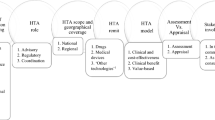Abstract
HTA and TA institutions at national parliaments (PTA) both share the same origin and of course have objectives and some of their methods in common. Nevertheless both TA branches developed in some distance during the 1970s and 1980s. Drawing on the case of biomedicine this paper outlines the differences between HTA and PTA, highlighting the “clinical perspective” of HTA and the “societal perspective” of PTA. It is shown that biomedicine which has developed rapidly during the last decade has hardly been dealt with by HTA, whereas it ranked quite prominent on the agendas of PTA institutions. Biomedical technologies became a subject of policy making beyond the boundaries of health care politics since biomedicine is perceived as an ethical challenge to society and not only as a medical innovation that has to be assessed by clinical experts. It is argued that there may however be good reasons to integrate the HTA and the PTA perspective in future TA on biomedical technologies.
Zusammenfassung
HTA- und TA-Institutionen im Rahmen nationaler Parlamenten (PTA) gehen auf denselben Ursprung zurück und verfolgen daher auch gemeinsame Ziele und haben manche ihrer Methoden gemeinsam. Dennoch haben sich die beiden TA-Zweige in den Sechziger- und Siebzigerjahren des vergangenen Jahrhunderts in einiger Distanz voneinander entwickelt. Anhand der Biomedizin als Fallbeispiel skizziert dieser Beitrag die Unterschiede zwischen HTA und PTA, wobei besonders auf die „klinische Perspektive“ der HTA und die „gesellschaftliche Perspektive“ der PTA abgezielt wird. Es wird gezeigt, dass sich die HTA mit dem Bereich der Biomedizin, der über das letzte Jahrzehnt eine rapide Entwicklung erlebt hat, kaum befasst hat, während PTA-Institutionen diesen Bereich mit hoher Priorität behandelt haben. Biomedizinische Technologien wurden zum Gegenstand von Policy-making, und zwar nicht nur im Rahmen der Gesundheitspolitik, da Biomedizin als eine ethische Herausforderung an die Gesellschaft betrachtet wird, und nicht nur als medizinische Innovation, die von klinischen Experten zu beurteilen ist. Trotz dieser Umstände könnte es jedoch gute Gründe geben, die Perspektiven von HTA und PTA in eine zukünftige TA für den Bereich der biomedizinischen Technologien zu integrieren.
Résumé
Les institutions de l’ETS et de l’ET dans les parlements nationaux (ETP) ont la même origine et par conséquent certains objectifs et méthodes en commun. Ces deux branches de l’ET se sont toutefois quelque peu éloignées l’une de l’autre au cours des années soixante-dix et quatre-vingts du siècle dernier. S’appuyant sur le cas de la médecine biologique, l’article esquisse les différences entre ETS et ETP et met en lumière la « perspective clinique » de l’ETS et la « perspective sociétale » de l’ETP. Il montre que l’ETS s’est peu intéressée à la médecine biologique, qui a connu un développement rapide au cours de la dernière décennie, tandis que les institutions d’ETP ont accordé une priorité élevée à ce domaine. Les technologies biomédicales ont fait l’objet de décisions politiques, et ceci au-delà des limites des politiques de la santé, étant donné que la médecine biologique est perçue comme un défi éthique pour la société, et pas seulement en tant qu’innovation médicale devant être évaluée par des experts en médecine. L’article postule qu’il y a toutefois de bonnes raisons pour intégrer les perspectives ETS et ETP dans une future ET sur les technologies biomédicales.
Similar content being viewed by others
Notes
The studies carried out in the field of health and healthcare by the member organisations of the European Parliamentary Technology Assessment (EPTA) Network during the 1990s were analysed by scanning their homepages and work programmes as far as available. This does not claim to give a systematic and comprehensive overview of what EPTA organisations have been working on in the medical field in the last decade but should nevertheless provide a rather reliable picture. Looking at the projects and publications of EPTA (without making a difference between comprehensive TA studies and short term projects).
HTA has been a main field of activity of the Institute of Technology Assessment at the Austrian Academy of Sciences from the beginning of the 1990s. This might be due to the fact that a specialised institution for HTA is missing so far in Austria.
References
Council of Europe (1997) Convention for the protection of human rights and dignity of the human being with regard to the application of biology and medicine. In: Convention on human rights and biomedicine. European Treaty Series, no 164
EUR-ASSESS Project Subgroup (1997) Report on methodology: Methodological guidance for the conduct of health technology assessment. Int J Technol Assess Health Care 13:186–219
EUR-ASSESS Project Subgroup (1997) Introduction to the EUR-ASSESS Report. Int J Technol Assess Health Care 13:133–143
Giddens A (1991) Modernity and self-identity. In: Self and society in the late Modern age. Polity Press, Cambridge
Hennen L (1999) Participatory Technology Assessment: A response to Technical Modernity? Sci Public Policy 26:303–312
Joss S, Bellucci S (eds) (2002) Participatory Technology Assessment: European perspectives. University of Westminster Press, London
Office of Technology Assessment (OTA) (1976) Development of medical technologies: Opportunities for assessment. United States Congress, Washington
Petermann Th, Sauter A (1996) Stand der Technikfolgen—Abschätzung im Bereich Medizintechnik. In: TAB-Arbeitsbericht Nr 39. Büro für Technikfolgen-Abschätzung beim Deutschen Bundestag, Bonn
Author information
Authors and Affiliations
Corresponding author
Rights and permissions
About this article
Cite this article
Hennen, L. Biomedical and bioethical issues in Parliamentary TA and in Health Technology Assessment. Poiesis Prax 2, 207–220 (2004). https://doi.org/10.1007/s10202-003-0051-4
Published:
Issue Date:
DOI: https://doi.org/10.1007/s10202-003-0051-4




